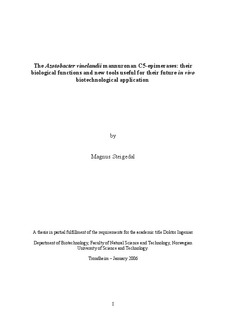| dc.description.abstract | Alginate, an industrially widely used polysaccharide composed of β-D-mannuronic acid (M) and α-L-guluronic acid (G), is produced by brown algae and certain bacteria (e.g. pseudomonads and Azotobacter vinelandii). The alginate monomers are grouped in blocks of M, G or MG. G-blocks enable the polymer to form gels by crosslinking (using cations like Ca2+). Commercially, alginates are utilized for their viscosifying and gel-forming properties. At present all commercially available alginates are harvested from brown algae, but with an ever increasing range of possible applications for the polymer alginate production from bacteria are now also being investigated.
Alginate in A. vinelandii is produced as an exopolysaccharide released into the growth medium in vegetatively growing cells, but under certain adverse environmental conditions the organism is able to undergo a differentiation process by which it develops into a desiccation resistant and morphologically distinct form designated cyst, which is surrounded by a rigid coat in which alginate is a major component. The alginate from both vegetatively growing cells and cysts contain G-blocks and therefore probably has a potential for commercial production. For all alginate producers the G residues are introduced at the polymer level by mannuronan C5-epimerases. A. vinelandii encode one Ca2+-independent periplasmic epimerase (AlgG) and seven secreted Ca2+-dependent epimerases (AlgE1-7). All the AlgE epimerases have been expressed recombinantly in Escherichia coli and their properties have been extensively studied in vitro. In contrast, much less is known about their in vivo functions and this Ph.D project was undertaken to develop a better understanding of their biological function and to generate a knowledge basis that later may be used to modify A. vinelandii genetically so that it can become an in vivo producer of bacterial alginates with predetermined properties.
To elucidate the in vivo roles of the AlgE epimerases in A. vinelandii the genes encoding each of them were individually disrupted. These interruptions had no clear effect on the structure of the alginates produced, or on the morphology of cells grown in shake-flasks (RA1 medium), but when the same cells were grown in fermentors (PM1 medium), the algE3 mutant (strain MS159) alginates contained only 8% G, in contrast to the 25 % found in alginates from wild-type cells grown under the same conditions. This result indicated that the phenotypes of the mutants may be significantly dependent on the growth conditions (Paper 2).
Based on the results from the single algE disruptions it appeared likely that more clear effects on the alginate structure and A. vinelandii biology would become more apparent if more than one epimerase gene was inactivated in one single strain. All algE genes with the exception of algE5 are clustered in the A. vinelandii chromosome, and this made it possible to delete the entire cluster, generating strain MS163. In this strain the algE5 gene was then interrupted, generating strain MS163171. Fermentor-grown cells of strain MS163 were found to produce alginates containing only 6% G, and the polymer products from strain MS163171 contained nearly undetectable levels of G (below 2%). In addition strain MS163171 was incapable of forming cystlike structures in RA1 medium and was unable to withstand desiccation in standard cyst-testing experiments. This observation is almost certainly linked to the inability of this strain to make G-blocks (Paper 2).
In conclusion, the experiments with the algE mutants for the first time directly showed that the AlgE epimerases are responsible for nearly all alginate epimerization in A. vinelandii. In addition this work shows that the AlgE epimerases are essential for the ability of the cells to differentiate into desiccation resistant cysts (Paper 2). The conclusions reached in these experiments are in complete agreement with the results obtained in a parallel study of a transport system needed for export of the AlgE epimerases. The studies of this system constitute a minor part of this PhD work, but it is important for the independent evidence further substantiating the conclusions on the role of the AlgE epimerases (Paper 1).
A very important spin-off of these results is that strain MS163171 seems to represent a very good starting point for production of tailor-made alginates, by constructing a new series of strains in which separate selected algE genes are expressed at carefully controlled levels.
Even from the start of this Ph.D project it was realized that to utilize A. vinelandii for production of alginates with predetermined structures, a new gene expression system was needed. No such specialized tools existed then, and it was therefore decided to try to identify and develop a new broad-host-range gene expression system that could be used in A. vinelandii. The new system was found in Acinetobacter sp. and is the promoter of chnB together with its positive regulator ChnR. The system was called Pb. Pb was tested for ability to induce luciferace in response to an externally added inducer and was shown to be inducible in several species (Paper 3). The Pb-promoter was planned to be used in combination with another system previously developed in our group, and which is based on the Pm promoter and its cognate positive regulator XylS. An example of such a combined use is illustrated in paper 3, where the technically more convenient alginate-producer Pseudomonas fluorescens is used as a test organism. This model experiment showed that the two systems in combination could be used to control alginate monomer structure. The prospects for future use of these systems to construct sophisticated production systems for alginate production in A. vinelandii therefore now seem promising. | nb_NO |
